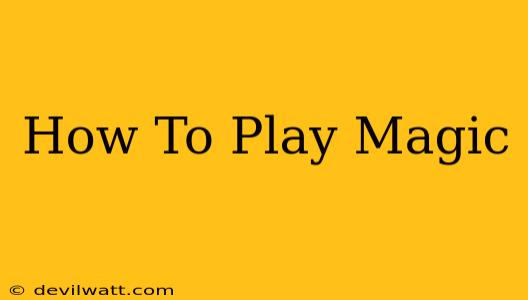Magic: The Gathering (MTG) is a complex but rewarding collectible card game with a massive global following. This guide will walk you through the basics, helping you understand how to play and get started in this captivating world of spells, creatures, and strategic battles.
Understanding the Core Mechanics
At its heart, MTG is a game of resource management and strategic combat. Players build decks of cards, aiming to reduce their opponent's life total from 20 to 0. Here's a breakdown of the core elements:
1. Lands: Your Mana Source
Lands are the foundation of your deck. They provide mana, the resource used to cast spells and summon creatures. Each land usually produces one mana of a specific color (e.g., red, blue, green, black, white). You'll need a good balance of lands to support your spellcasting.
2. Creatures: Your Fighting Force
Creatures are cards that represent warriors, beasts, and magical beings. They have power (attack strength) and toughness (defense strength). You use mana to summon creatures onto the battlefield, where they can attack your opponent or block incoming attacks.
3. Spells: Your Strategic Arsenal
Spells are cards that offer a vast array of effects. Some deal damage, others enhance your creatures, and some disrupt your opponent's strategies. They are crucial for controlling the game and achieving victory. Instant spells can be played at any time, while sorcery spells can only be played during your turn.
4. Enchantments and Artifacts: Long-Term Advantages
Enchantments and artifacts provide ongoing effects that can significantly impact the game's flow. Enchantments are often tied to specific game mechanics, while artifacts are typically powerful items or devices.
Gameplay: A Step-by-Step Guide
- The Game Begins: Each player shuffles their deck and draws seven cards.
- The Turn Structure: A player's turn consists of several phases:
- Untap Step: Your lands and creatures become untapped (ready to be used).
- Upkeep Step: Triggers certain card abilities.
- Draw Step: You draw a card.
- Main Phase 1: You can play lands, cast spells, and summon creatures.
- Combat Phase: Declare attackers, blockers, and damage is dealt.
- Main Phase 2: More spellcasting and creature summoning.
- End Step: Triggers certain card abilities.
- Cleanup Step: Discard excess cards in hand if necessary.
- Attacking and Blocking: Attacking involves sending your creatures to attack your opponent. Your opponent can then use their creatures to block these attackers, mitigating damage.
- Winning the Game: Reduce your opponent's life total to 0 to win the game.
Building Your First Deck
Creating your first deck can be daunting, but it doesn't have to be! Start with a preconstructed deck to grasp the basics and gradually build your understanding of the game's nuances. Consider these tips when constructing your own deck:
- Choose a Theme: Focus on a particular color combination or strategy.
- Balance Your Deck: Include a sufficient number of lands to support your spells and creatures.
- Synergy: Select cards that complement each other, creating powerful combinations.
- Consider your playstyle: Do you like aggressive, controlling, or combo strategies?
Beyond the Basics
Once you've mastered the fundamentals, there's a wealth of advanced strategies and complexities to explore. You can join a local game store community, engage with online resources, and participate in tournaments to hone your skills and discover new strategies.
Mastering Magic: The Gathering is a journey, not a destination. Enjoy the process of learning, exploring, and strategizing, and have fun battling your opponents!

